It can be overwhelming to try to figure out what is best to plant in front of your house with so many shrub options available. Here we’ll provide the best 20 shrubs to plant in front of your house and why you’ll love them. Get your gardening gloves on and get digging!
Juniper (Juniperus spp.)
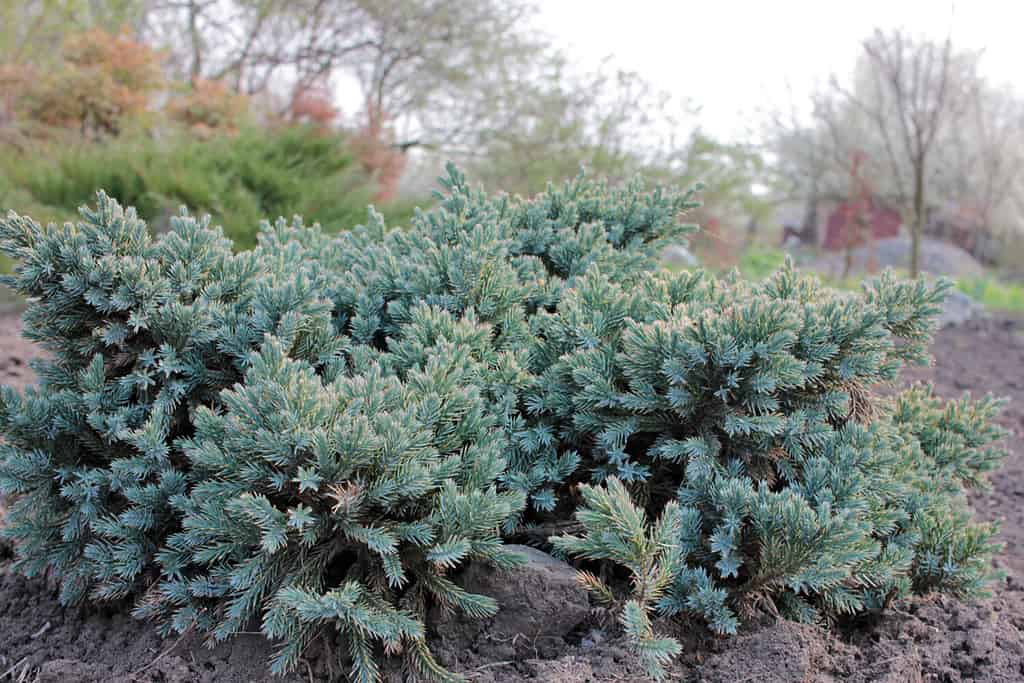
‘Blue star’ juniper is one of the most recognizable juniper species.
©Juver/Shutterstock.com
There are around 60 species in the Juniperus genus. Some are blue-green in color, others are classic evergreen, and some even appear as a greenish-gray color. These species typically grow well in USDA zones 3-9, which covers most of the continental US. Take care not to go crazy with pruning, as these plants don’t tolerate heavy pruning very well. However, if you do find your plants falling victim to grazing deer, juniper, and other shrubs in this list are excellent choices to keep your landscaping foliage from getting chewed. When planting, choose an area with full sun to use any Juniper species as a hedge, shrub, or ground cover plant.
Boxwood (Buxus spp.)

Well-pruned boxwoods can take any shape.
©iStock.com/Yarygin
Boxwood shrubs are among the most popular for their hardiness, variety, structural form, and ease of growing. The colors are most often a glorious green with a shiny sheen, and some have gold variegation. These are commonly shaped into topiaries or trimmed into whatever shaped hedge you desire. Common varieties include English boxwood, Japanese boxwood, and American boxwood. While they are relatively cold-hardy, they perform best in zones 5-9.
Euonymus (Euonymus spp.)

The common name of “burning bush” is given because of its intense red-colored foliage. It’s sure to make a statement in the front yard!
©anmbph/Shutterstock.com
Euonymus shrubs, also known as spindle trees, are another genus with many different species, but one of the most impressive is E. alatus, or burning bush. It is a firey red shrub that makes a statement and can grow up to 15 feet wide and tall. This is a mostly deciduous genus, which means the plants in this genus will lose their leaves for the fall and winter. An evergreen species is E. japonicus, which features glossy green leaves and white edges. Depending on what species you choose, a full to part sun spot will be most suitable. They are grown best in zones 4-9.
Holly (Ilex spp.)
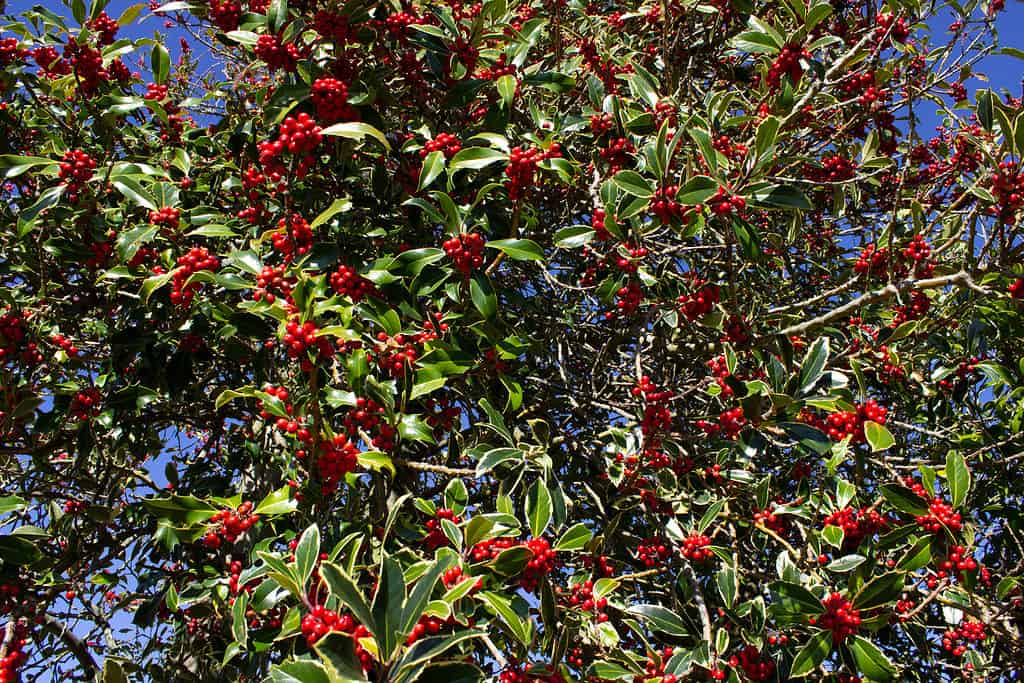
A common holly with bright red berries.
©EveTravels/Shutterstock.com
Hollies are one of those plants that almost anyone can recognize due to their pointed, glossy evergreen leaves and bright red berries. Their uses are widespread, whether you want to use them as a privacy border plant or display them prominently as a specimen plant. The size and color of the berries will change depending on the variety chosen: Ilex crenata ‘Hetzii’ will boast black berries and lighter green leaves without the classic points along the margins, whereas if you’re looking for a more “classic” look, try out Ilex x meservea ‘Blue Princess’. Most species won’t grow to be too large, so expect a spread between 3-6 feet for most. They are highly tolerant of pruning which makes them exceptional topiary plants.
Rhododendron (Rhododendron spp.)
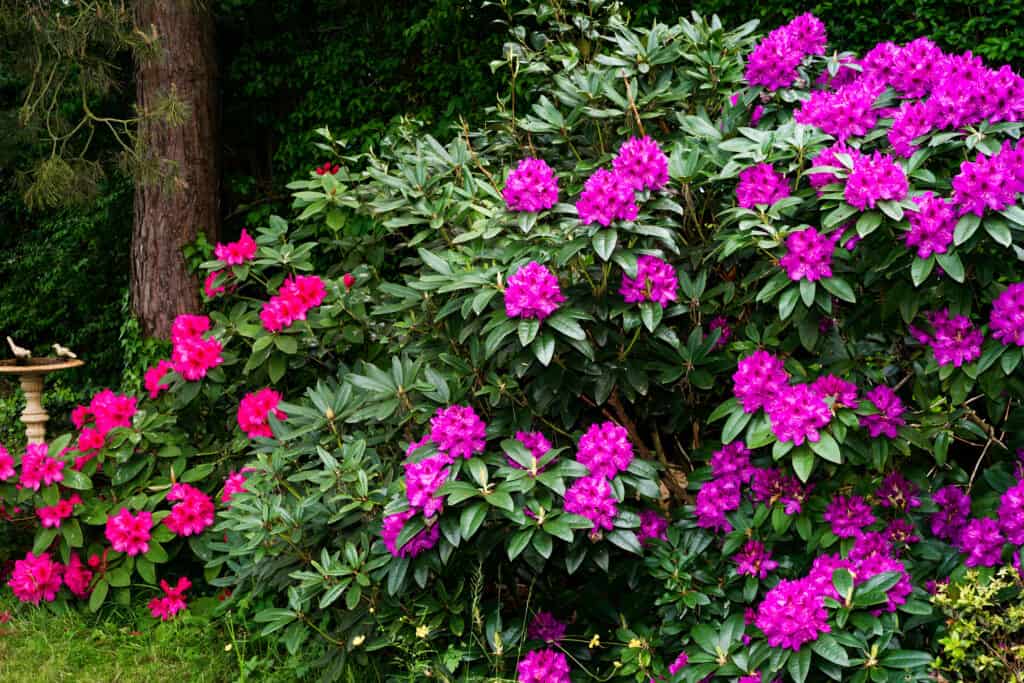
Rhododendrons are one of the few large flowering plants that don’t have full-sun requirements.
©iStock.com/Jean-Luc Farges
If your home doesn’t get too much direct light, rhododendrons can help you add some color and life to a shaded area. Grown best in part sun to shade in most of the continental US (zones 3-9) rhododendrons are a good balance between colorful blooms and evergreen foliage. These are on the larger side, some ranging up to 20 feet wide, but if you’re looking for something smaller check out azaleas. These are in the same genus. Regardless of your preference for size or color, there is something in the Rhododendron genus for you!
Forsythia (Forsythia spp.)
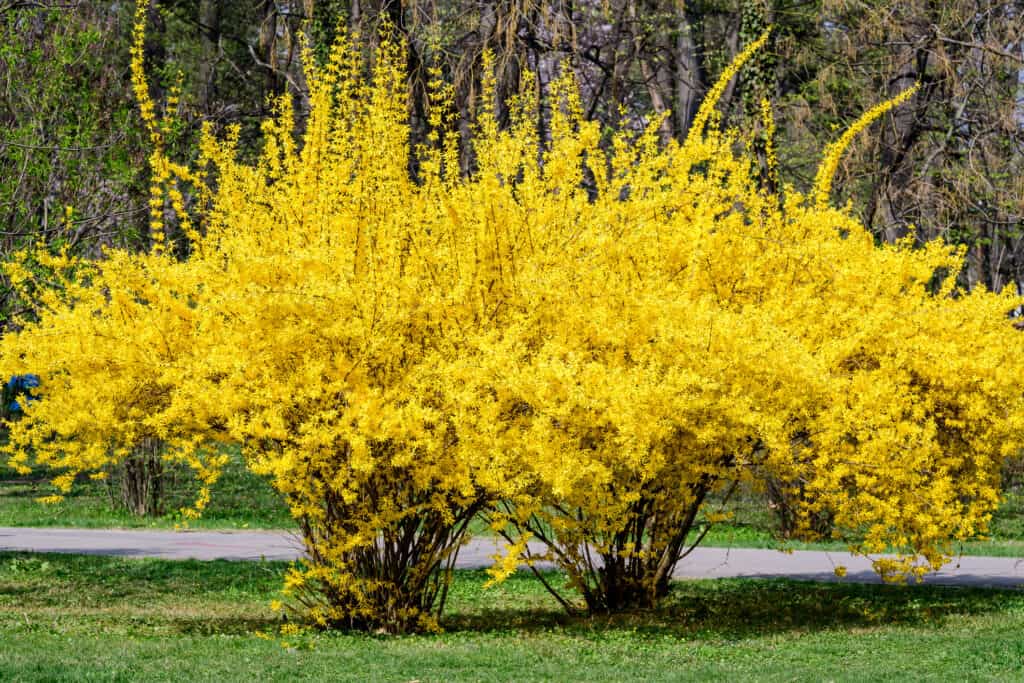
Forsythia branches can also be trimmed and displayed in a tall vase to bring their beauty indoors.
©iStock.com/Cristina Ionescu
These blooming shrubs boast a vivid golden hue when they flower and are the perfect complement to an otherwise green landscape. Not only do the flowers attract the eye, but they’re also good to draw in pollinators to your yard. Forsythia shrubs are also pretty tolerant of many conditions and can grow without issue in zones 3-8, and can handle full to partial sun. They can get rather large, up to 12 feet wide and 10 feet tall, so be sure to prune regularly to keep the size manageable and suited to your taste.
Hydrangea (Hydrangea spp.)
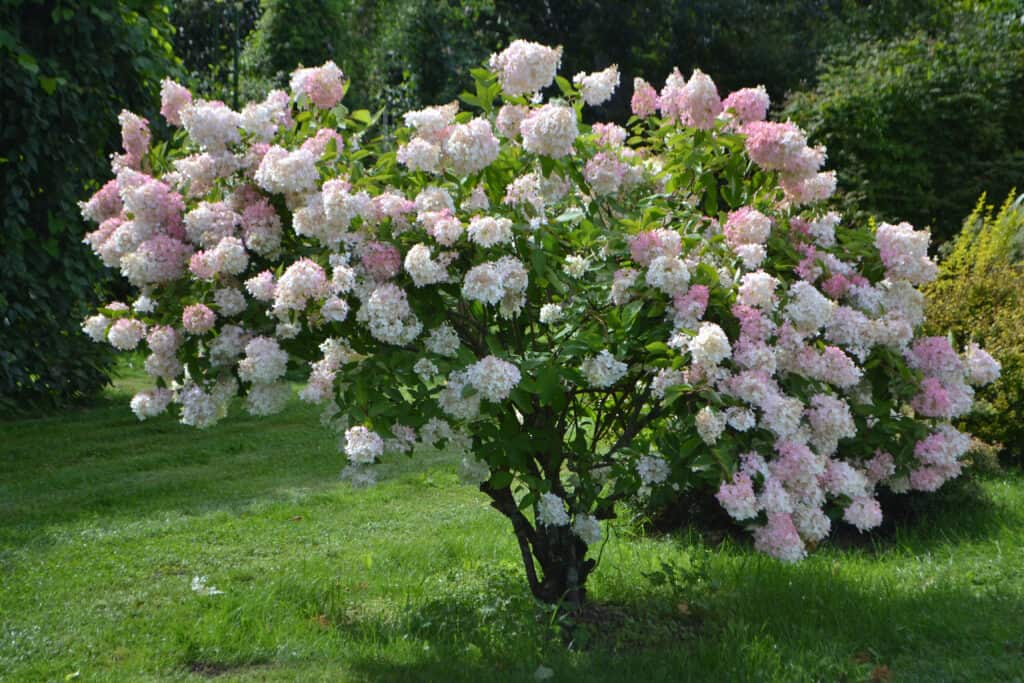
Hydrangeas can bloom in a variety of colors from green to various shades of pink, blue, and purple.
©Edita Medeina/Shutterstock.com
The colorful pom-pom blooms of a hydrangea can make anyone swoon. Interestingly, the soil acidity is what determines the color of your hydrangeas! Full morning sun is best for these flowering beauties, and they do enjoy some afternoon coverage to keep from getting scorched. If the soil you’re planting in is rich, you will find fertilizer use is not typically needed. They are hardy in zones 5-9. Be sure you give it plenty of room to grow, as most hydrangea shrubs can grow past 20 feet tall and 6 feet wide.
Rose (Rosa spp)
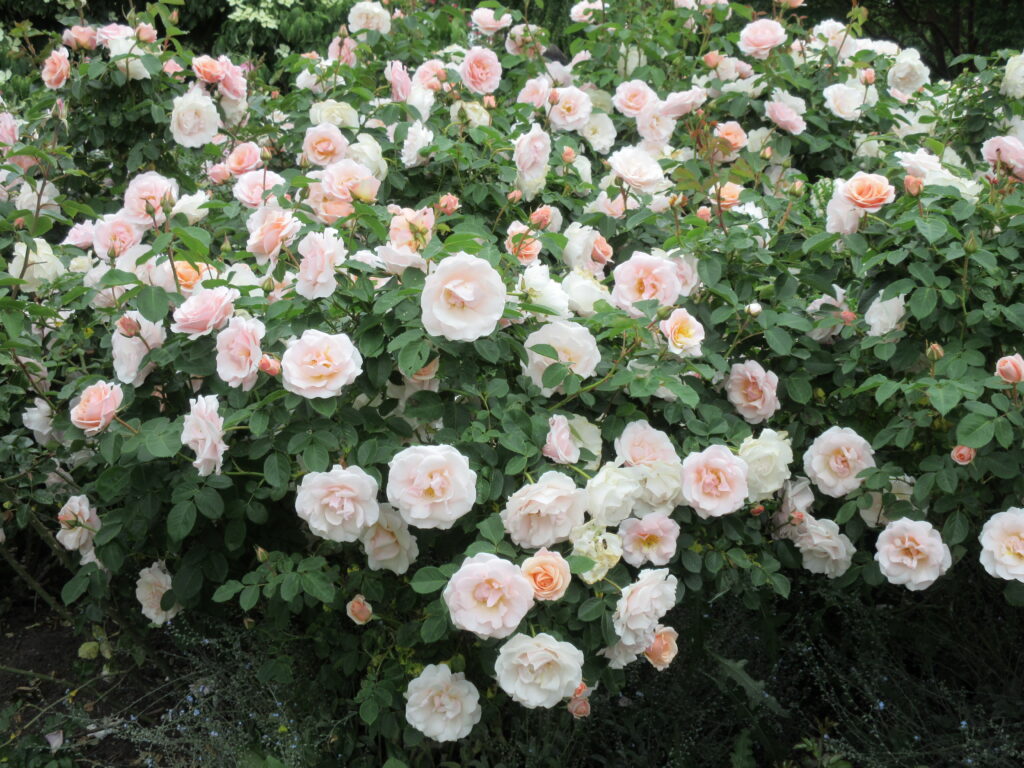
Roses are another flowering shrub with plentiful variety for every gardener’s vision.
©iStock.com/Rolleen Annie and Rowena Ho K.
Roses are a classic choice for front-of-house landscaping for a reason (or a few). They are gorgeous, come in many different colors and styles, and have a lovely scent about them. Not only do they provide a good barrier due to their dense growth and thorny stems, but the flowers are useful for decorating your home too! The ideal zones for roses are 5-8, but some can be grown outside of these zones on both ends of the spectrum. Full sun will yield the best flower and foliage development. Rose bushes are tolerant of pruning so you can decide how large or wide you want it to grow. Like other perennials, with proper care, you can expect to get many years out of your rose shrubs.
Lavender (Lavendula angustifolia)
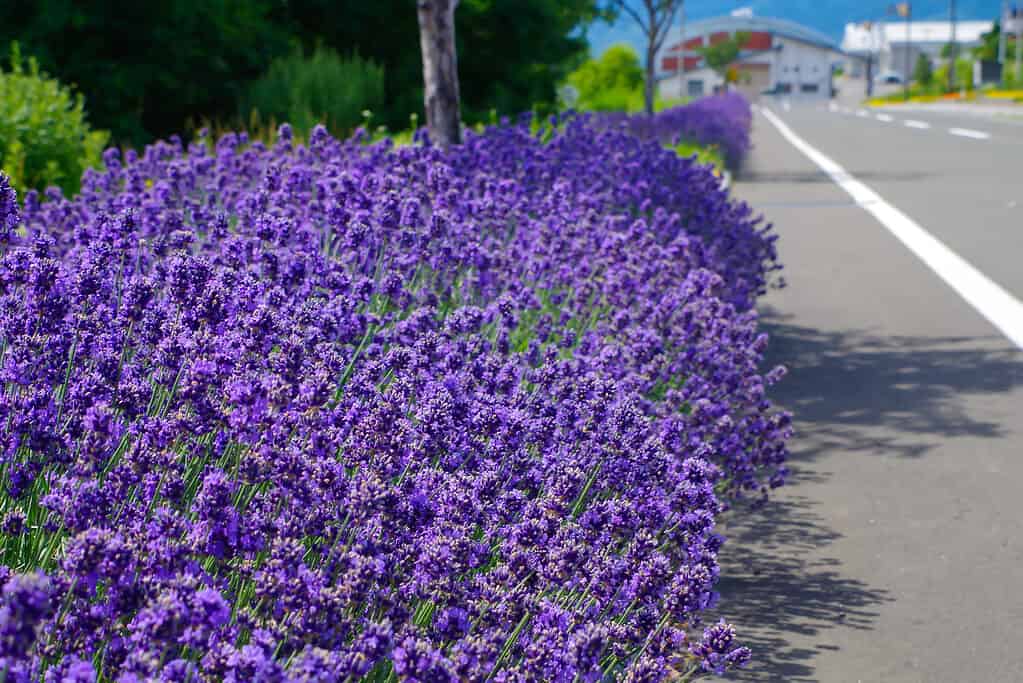
English lavender shows off its bright purple flowers, making for a great addition to any landscape.
©ajisai13/Shutterstock.com
Lavender shrubs are relatively dainty, fragrant, and a treat to look at. Most species max out around 40 inches tall (or about 3.5 feet) and are best grown in dry areas, though they are technically hardy from zones 5-9. These shrubs will provide many blooms throughout the spring and can be trimmed to be added to bouquets or dried out for their scent to be enjoyed well into the colder months. This plant is not evergreen, but it is a perennial so it will come back each spring for many years when cared for properly.
Dwarf Japanese cedar (Cryptomeria japonica ‘Globosa Nana’)
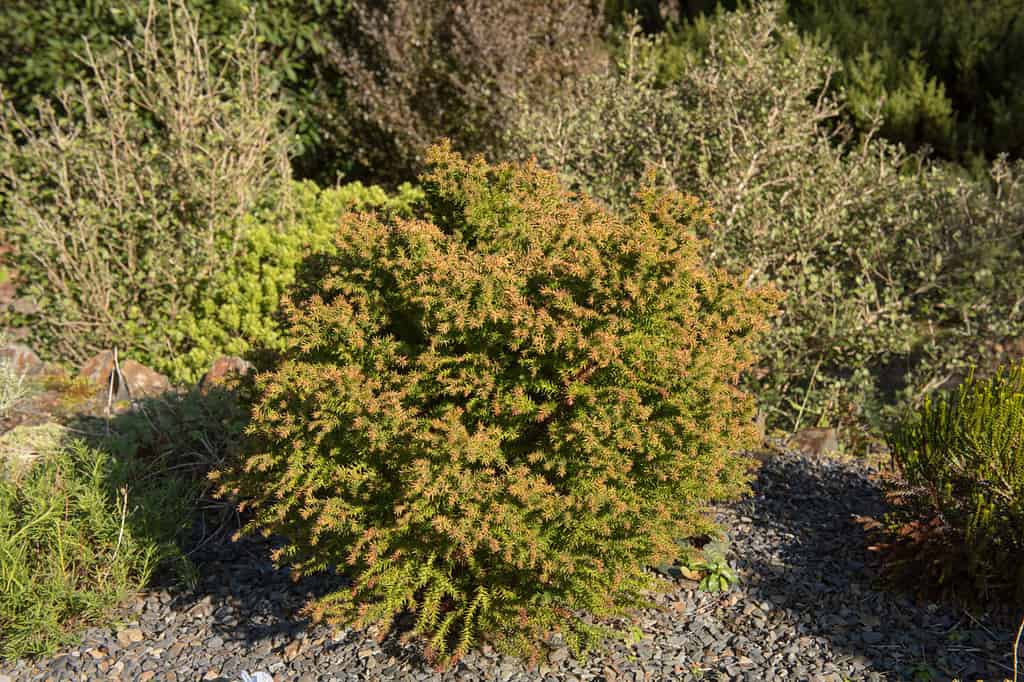
Cedars of any variety can be trimmed to maintain a specific shape for the desired appearance.
©Peter Turner Photography/Shutterstock.com
While many different cedars can make good additions as a shrub to the front of the house, the dwarf Japanese cedar is a particularly striking specimen. If you’re lucky enough to live in the zone it thrives in (USDA 5-7) then this might be a species to seriously consider. It grows in a dense dome-shape that doesn’t require much upkeep in both pruning needs and care. They are evergreen but during the winter their color changes to a rusted red color, giving your winter landscape a different look and feel. The best spot for this shrub is an area with full to part sun.
Weigela (Weigela florida)
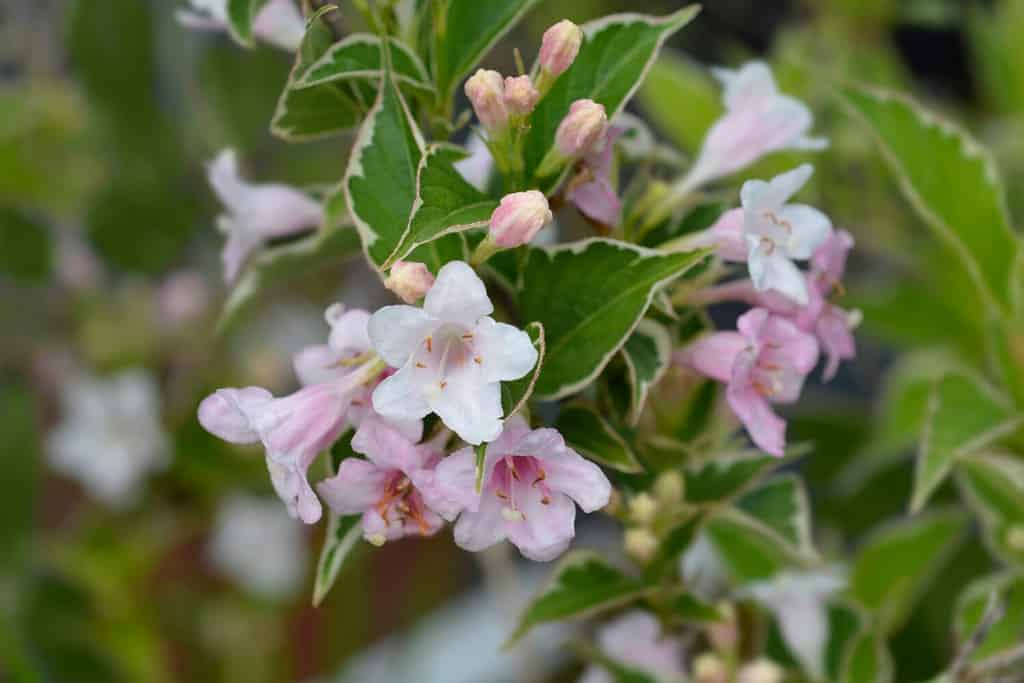
Some pink flowers on a variegated
Weigela florida.
©Nahhana/Shutterstock.com
Weigela shrubs are suitable for the areas that receive a spectrum of sunlight, tolerating full sun and dappled sun with similar results. As these shrubs grow they can get a bit wild, so pruning and some maintenance are required to keep it looking neat and compact. While insects tend to stay away from these lovely plants, they are susceptible to deer grazing. Their tube-shaped flowers are reminiscent of azaleas or rhododendrons in appearance with colors ranging from white to rosy pinks. Depending on the cultivar chosen, these plants can grow up to 10 feet tall on the larger side but smaller cultivars are suitable for container planting.
Hosta (Hosta plantaginea)

This hosta variety has dusty purple flowers beautifully punctuated by white and bright green leaves.
©Gardens by Design/Shutterstock.com
Hostas, or plantain lilies as they are commonly called, are ideal for someone looking for a low-growing shrub option to plant in front of your home. Partial shade is the condition they will do their best. They grow relatively quickly and are easy to deal with, requiring little maintenance other than being well-watered upon planting. Hosta colors can be variegated, light green, dark green, or even yellow. The flowers grow on long stalks and are clusters of funnel-shaped individuals which attract butterflies, hummingbirds, and bees. They are perennials, too, so you don’t have to worry about having to dig up and replant these every year. Expect them to die back in the winter during their dormancy period, but know you don’t have to interfere for them to come back just as beautiful in the spring.
Peony (Paeonia lactiflora)

Peonies can range from light pink to a deep burgundy color.
©iStock.com/yrabota
Peonies are one of the first flowering plants in the spring, and they do not hold back! Their large, colorful, and scented blooms are sought after due to their short flowering period. After flowering, their dark green palm-shaped leaves stick around. These are some of the best shrubs to plant in front of your house because of their beauty and longevity. Mature species can live up to 100 years. They are also suited for a variety of climates, ranging from zones 2-8, depending on the variety planted. Different varieties can be planted together so you can enjoy blooms throughout the season.
Rosemary (Salvia rosmarinus)

A tasty herb and beautiful shrub, rosemary plants have it all!
©Maren Winter/Shutterstock.com
Rosemary is not just for your herb garden anymore! These versatile plants can be kept low-growing (under 2 feet tall), or you can let them grow to a max height of about 6 feet. This shrub will retain its leaves, and you can use them year-round in the kitchen as a culinary herb. They will give small, inconspicuous, light purple flowers when well-cared for in the summer. They are also fairly drought-resistant and don’t need too much pruning, so they are ideal shrubs for someone looking for a low-maintenance but attractive plant. If you live in a colder region (below zone 6), you can still use these plants as landscape plants but consider container gardening so you can bring them inside during the winter.
David viburnum (Viburnum davidii)
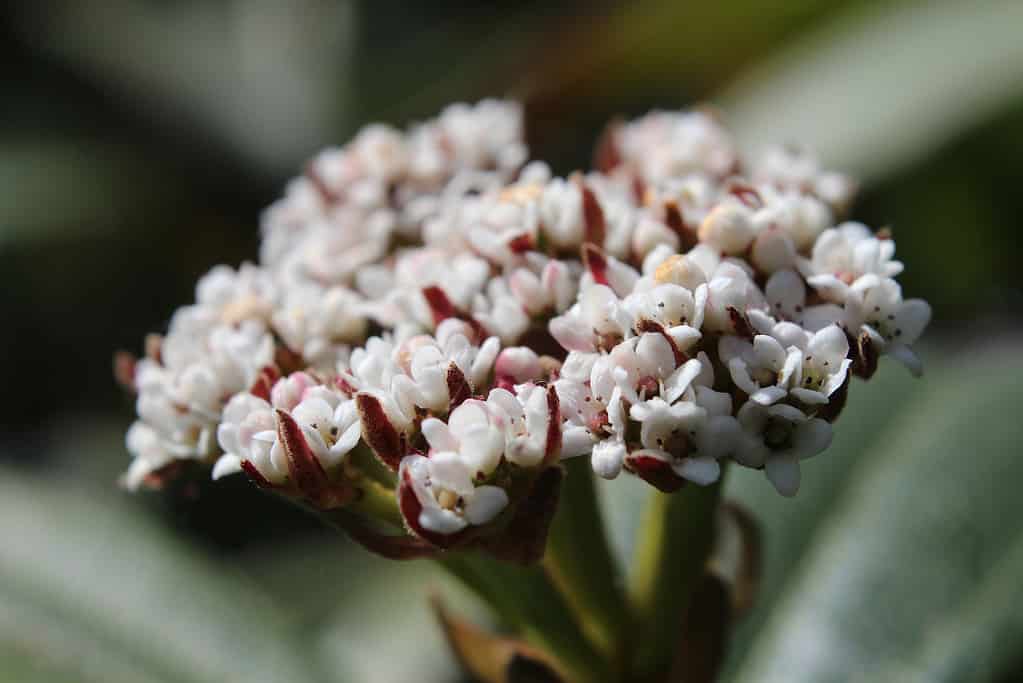
Their small flowers cluster together to pack a punch when displayed against their dark green leaves and reddish stems.
©Imladris01/iStock via Getty Images
These shrubs are known for their showy flowers, blue fruits, and evergreen leaves with a somewhat striped appearance. It’s a relatively small shrub (around 3 feet high and 4 feet wide at maturity) with a matching small range in the US (zones 7-9), but if you can utilize this shrub, you won’t have regrets. It’s attractive enough without the flowers and fruits that it would still be eye-catching even in the fall and winter. David viburnum gives its full potential when under full sun, though part sun will not reduce its charm.
American arborvitae (Thuja occidentalis)
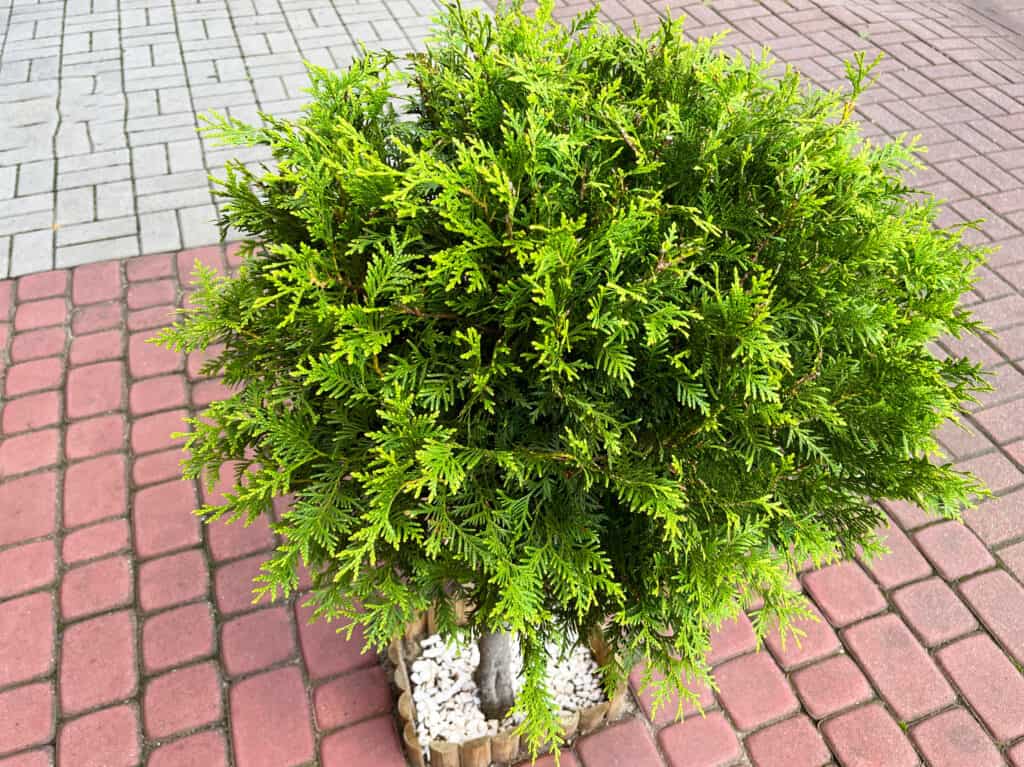
Arborvitaes are a great choice for those who want some pizzazz to the front of their house without having to worry too much about maintenance.
©iStock.com/Aliaksandr Yarmashchuk
Arborvitae seems to be an essential shrub to plant in front of your home for a classic landscape look. The American arborvitae has plenty of cultivars that can be chosen depending on the look you’re going for, whether it is a short and stout look, long and columnar, or even golden in color. Some have pendulous leaves like weeping willows, and others are more compact. The low-growing varieties can max out at around 3 feet, though larger species can get up to 70 feet tall! There are, of course, in-height in between also. A tip for row-planting: stagger them in a zig-zag pattern to give them room for air circulation and growth. This will also lend to a more “natural” appearance.
Yew (Taxus spp.)

The red berries are actually “arils” which are also the edible “seeds” in a pomegranate!
©iStock.com/Leo Malsam
Yews are a good option to add some structure to your front yard’s landscape, with many different varieties to choose from depending on the overall size and shape you want. It is very tolerant of pruning and grows well in containers. Pair these shrubs with some flowering specimens, and you’ll have a nicely manicured yard in no time! These are also winter-hardy plants. They do have a fragrance to them to attract birds that eat their berries, but these berries are toxic, so be sure to keep them away from children and pets. Yews are particularly slow-growing but long-lived, so if you’re looking for something sizable and don’t want to wait, choose a more mature plant. Just know how large it will get in the future, so there aren’t any surprises!
Gardenia
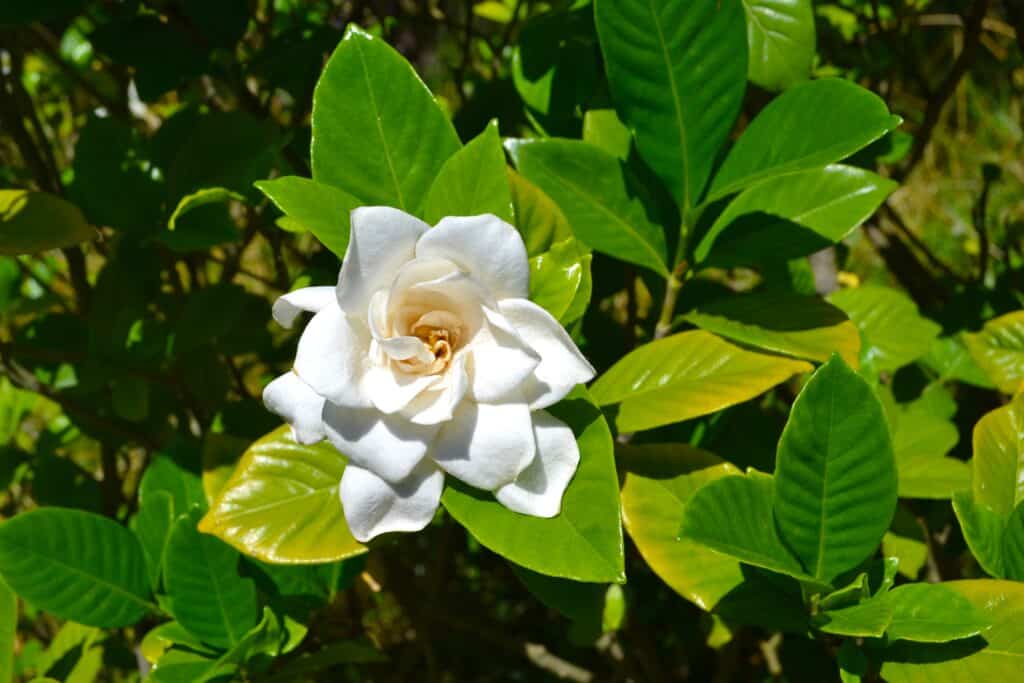
Gardenia flowers juxtapose the dark green foliage for a dramatic look during the spring and summer.
©NADII_art/Shutterstock.com
If you’re looking for a shrub that will flower in the spring and summer but also retain its leaves during the cooler seasons, gardenias are one of the best shrub options to plant front and center in your yard. Their large, perfumed blooms are tantalizing for both humans and pollinators, such as birds and butterflies. They thrive in warmer regions of the US, around zones 7-11, and can tolerate full to part sun. Keep in mind that with most flowering species, lower sun availability will reduce blooms.
Cypress (Cupressus spp.)
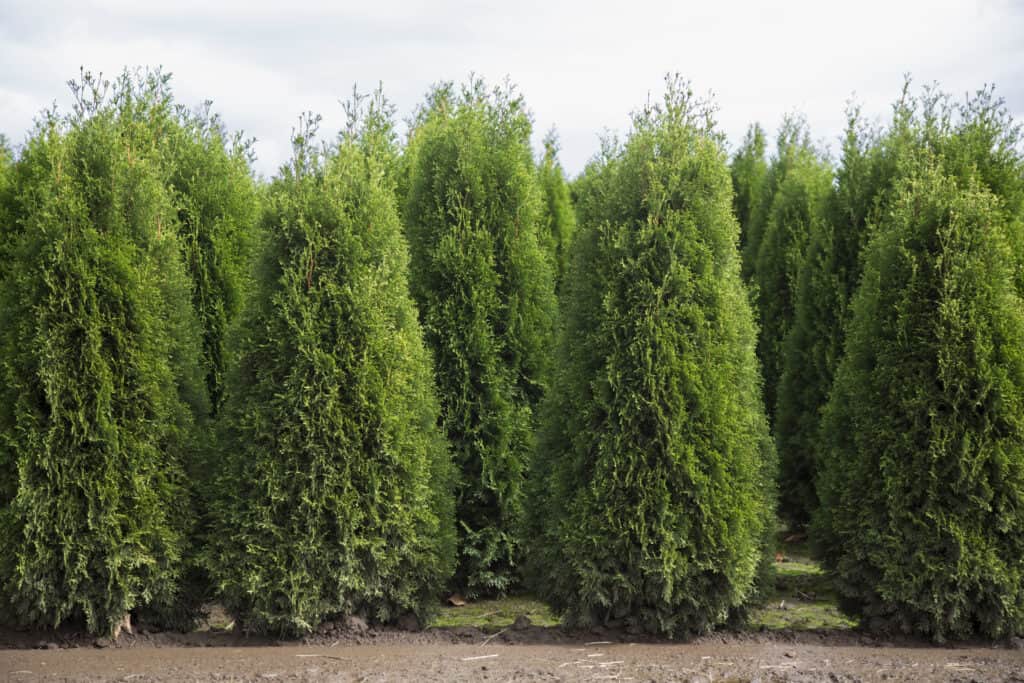
Cypresses are good choices if you’re looking to add many plants in a row to the front of your home.
©Jacquie Klose/Shutterstock.com
If you’re looking for something a bit more natural and subtle, many cypress shrubs have an understated beauty to them. However, this doesn’t mean there aren’t some electrifying ones out there. Lemon cypress (Cupressus macrocarpa ‘Goldcrest’) shrubs are taller shrubs with feathery, bright greenish-yellow leaves. A classic choice for privacy borders is Leyland cypresses (Cupressus x leylandii) since they grow up to two feet per year until they reach their maximum height of 60-70 feet. Along with varied appearances, there are also species available for various light availability, from full sun to part shade. If you’re in USDA zone 4-10, you’re very likely to find a cypress shrub to suit your needs.
Barberry (Berberis spp.)
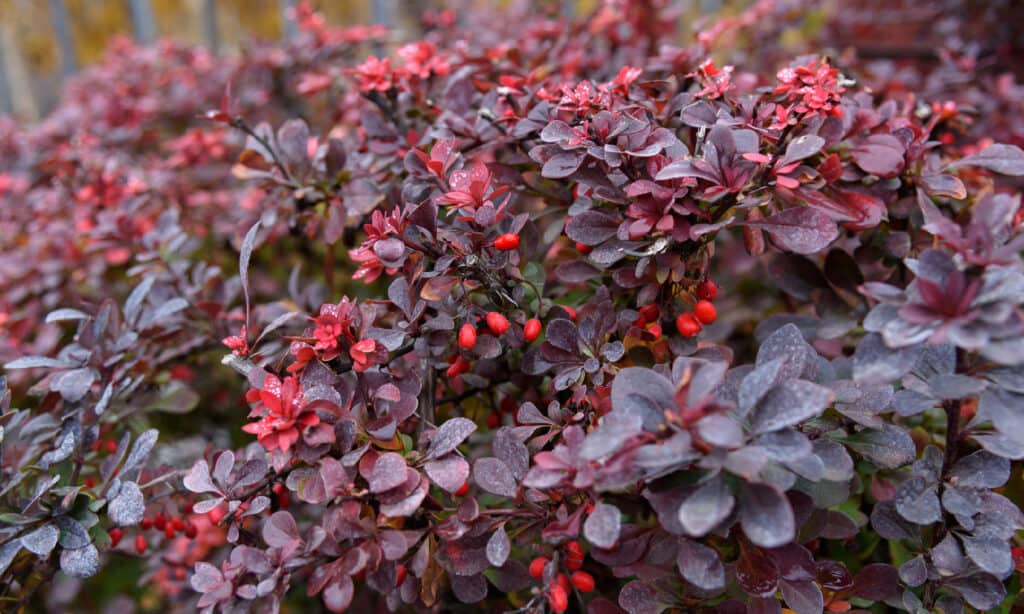
Japanese barberry, or
Berberis japonicahas deep red leaves and red berries to match.
©iStock.com/Oleg Kodola
Barberry shrubs are some of the hardier shrubs available and are a great shrub to plant in front of your house. They’re deer-resistant and come in many different colors and growth habits. Barberries are also pretty resistant to hard pruning, heavy foot traffic, and drought. Most, if not all, species will prefer full sun to bring out their brilliant colors and keep the foliage dense. For privacy hedges, check out varieties like the Helmond Pillar Barberry. Concorde Japanese Barberry gives a “shrubbier” look and also has dramatic dark purple leaves. Beware, they do have small but sharp thorns!
Final Note
Upon finding the shrub you love, be sure to check it against your state’s list of invasive plants. Invasive plants can spread rapidly and overtake areas far from their original planting site, so it’s always best to plant mindfully.
| Plant | Zones | Evergreen or deciduous |
|---|---|---|
| Juniper | 3-9 | Evergreen |
| Boxwood | 5-9 | Evergreen |
| Euonymus | 4-9 | Species dependent |
| Holly | 5-9 | Evergreen |
| Rhododendron | 3-9 | Evergreen |
| Forsythia | 3-8 | Deciduous |
| Hydrangea | 5-9 | Deciduous |
| Rose | 5-8 | Deciduous |
| Lavender | 5-9 | Deciduous |
| Dwarf Japanese cedar | 5-7 | Evergreen |
| Weigela | 4-8 | Deciduous |
| Hosta | 3-9 | Deciduous |
| Peony | 3-8 | Deciduous |
| Rosemary | 6-10 | Evergreen |
| David viburnum | 7-9 | Evergreen |
| Arborvitae | 3-8 | Evergreen |
| Yew | 3-8 | Evergreen |
| Gardenia | 7-11 | Evergreen |
| Cypress | 4-10 | Evergreen |
| Barberry | 4-8 | Species dependent |
The photo featured at the top of this post is © Juver/Shutterstock.com
Thank you for reading! Have some feedback for us? Contact the AZ Animals editorial team.







